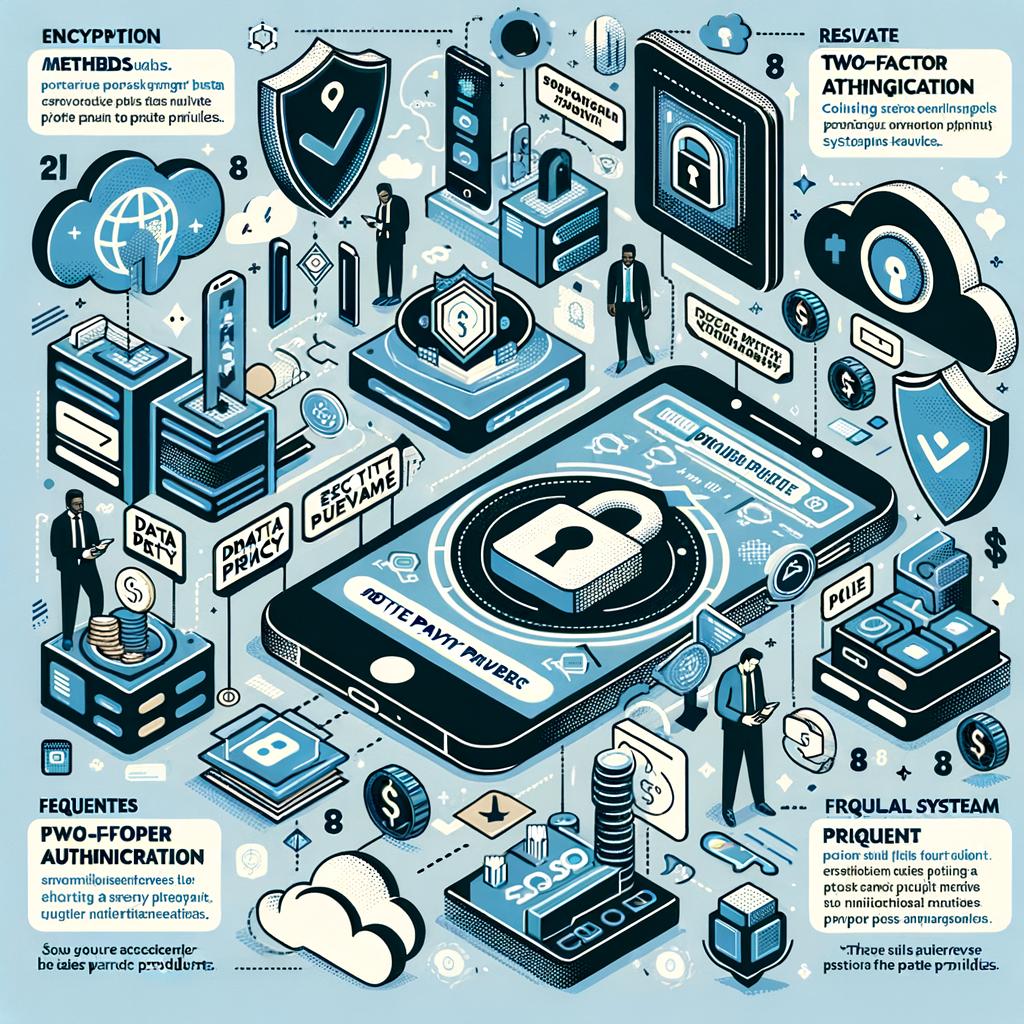How Mobile Payment Solutions Fit into Data Protection Regulations
Hey there tech-savvy folks! Have you ever wondered how those nifty mobile payment solutions manage to jive with all those stringent data protection regulations? Well, grab a cup of joe, sit back, and get ready to dive into the captivating world where cutting-edge technology meets the safeguarding of sensitive information – it’s time to explore how mobile payment solutions fit into data protection regulations! We’re about to unravel the mysteries of this digital dance, so get your groove on and let’s rock and roll!
Mobile Payment Solutions: Keeping Your Data Secure in the Digital Age
In today’s digital age, where convenience is a top priority, mobile payment solutions have emerged as a game-changer. With just a tap on our smartphones, we can complete transactions swiftly and effortlessly. However, amidst this convenience, there arises an important concern: the security of our data. It’s essential to understand how mobile payment solutions align with data protection regulations to ensure the safety of our sensitive information.
-
Complying with Data Protection Laws:
With the rise in data breaches and cyber threats, governments worldwide have implemented strict data protection laws to safeguard users’ personal information. Mobile payment solutions, such as Apple Pay and Samsung Pay, have integrated robust security measures to ensure compliance with these regulations. By encrypting transaction data and utilizing tokenization techniques, these solutions offer an extra layer of security that protects your financial details from falling into the wrong hands. -
Two-Factor Authentication:
To enhance security, most mobile payment solutions employ two-factor authentication, which adds an extra verification step. In addition to inputting your payment details, you might need to authenticate using fingerprint recognition or a unique passcode. This authentication process bolsters the protection of your data, limiting the chances of unauthorized access. So the next time you make a payment with your phone, rest assured that stringent security measures are in place to safeguard your valuable information.
| Mobile Payment Solution | Security Measures |
|---|---|
| Apple Pay | – Secure Enclave for storing encrypted data – Device-specific generated codes for transactions – Two-factor authentication |
| Samsung Pay | – Tokenization to protect card data – Biometric authentication (fingerprint/iris recognition) – Magnetic Secure Transmission (MST) for wider acceptance |
As the world continues to rely on mobile payment solutions for quick and seamless transactions, it’s crucial to understand how these technologies prioritize data protection. Embracing innovations like encryption, tokenization, and two-factor authentication, mobile payment solutions align with data protection regulations and work tirelessly to keep your personal information secure. So, embrace the convenience of mobile payments, knowing that your data is in safe hands!
Navigating New Data Protection Regulations: A Simplified Guide for Mobile Payment Solutions
Mobile payment solutions have revolutionized the way we handle transactions, providing convenience and efficiency to both businesses and consumers. However, with new data protection regulations coming into play, it is essential for mobile payment solutions to adapt and ensure the security of sensitive user information.
One of the main challenges that mobile payment solutions face in light of new data protection regulations is the need to comply with strict privacy standards. This includes obtaining explicit consent from users before collecting and processing their personal data. Additionally, mobile payment providers must implement robust security measures to safeguard this data from unauthorized access or breaches.
To navigate these regulations effectively, mobile payment solutions can take the following steps:
-
Conduct a thorough data audit: Identify the types of personal data collected, processed, stored, and shared by the mobile payment solution. This will help pinpoint potential areas of vulnerability and enable proactive measures to be implemented.
-
Implement strong encryption: Encrypting user data ensures that even if it is intercepted, it remains unreadable and unusable to unauthorized parties. Mobile payment solutions should prioritize end-to-end encryption to protect sensitive information during transit.
-
Provide transparent data policies: Clearly communicate to users how their data is collected, stored, used, and shared. User-friendly privacy policies and terms of service should be readily accessible and easy to understand.
-
Regularly update security protocols: As technology advances and new threats emerge, mobile payment solutions must stay ahead of the curve by continuously updating their security measures. Regular security audits and penetration testing can help identify weaknesses and address them promptly.
Navigating new data protection regulations can be a complex task for mobile payment solutions. However, by prioritizing user privacy and implementing robust security measures, these solutions can continue to provide seamless and secure payment experiences for all.
Best Practices for Mobile Payment Providers: Ensuring Data Privacy Compliance
Mobile payment solutions have revolutionized the way we make transactions, offering convenience and efficiency like never before. However, with the increasing use of mobile payments, it is crucial for providers to align their practices with data protection regulations. Ensuring data privacy compliance is not only a legal requirement but also essential for maintaining customer trust and loyalty.
To adhere to data protection regulations, mobile payment providers should implement best practices that safeguard personal information. Here are some key strategies to consider:
-
Implement strong authentication protocols: By requiring strong passwords, biometric verification, or two-factor authentication, mobile payment providers can enhance the security of customer data.
-
Encrypt sensitive data: Encrypting data during transmission and storage acts as an additional layer of protection against potential cyber threats, reducing the risk of unauthorized access to personal information.
-
Regularly update security measures: Staying up-to-date with the latest security patches and employing industry-standard encryption algorithms helps to address vulnerabilities promptly, safeguarding customer data from potential breaches.
Securing Your Customers’ Information: Why Mobile Payment Solutions Must Prioritize Data Protection
Mobile payment solutions have revolutionized the way we make transactions, allowing for quick and convenient payments with just a tap of our smartphones. However, in an era where data breaches and cybercrime are on the rise, it is crucial for these solutions to prioritize data protection to ensure the safety and security of your customers’ information.
With the increasing reliance on mobile payments, it is vital for businesses to comply with data protection regulations to maintain customer trust and avoid potential legal consequences. Prioritizing data protection not only safeguards sensitive information such as credit card details, but also ensures that personal data, such as names, addresses, and contact information, remains safe from unauthorized access.
When it comes to data protection, mobile payment solutions should include essential security measures to mitigate the risk of data breaches:
- Encryption: Encrypted communication channels and encrypted storage provide an additional layer of security, making it harder for hackers to intercept and decode sensitive data.
- Tokenization: By replacing card details with unique tokens, mobile payment solutions can protect customers’ financial information by ensuring that sensitive data is never stored or transmitted in its original form.
- Multi-factor authentication: Implementing multi-factor authentication can add an extra level of security, requiring users to provide additional verification steps, such as fingerprint scans or facial recognition, to authorize transactions.
Moreover, mobile payment solutions should regularly update their software and infrastructure to address any vulnerabilities and stay ahead of emerging threats. By investing in robust data protection measures, businesses can not only safeguard their customers’ information but also maintain a competitive edge in the market.
Key Benefits of Prioritizing Data Protection Statistics Enhances customer confidence and trust 87% of consumers are more likely to trust businesses that prioritize data protection Reduces the risk of costly data breaches Data breaches can cost affected businesses an average of $3.86 million Ensures compliance with data protection regulations Non-compliance with regulations can result in penalties of up to 4% of annual global turnover or €20 million, whichever is greater In conclusion, mobile payment solutions play a significant role in data protection regulations. By prioritizing data protection through robust security measures, businesses not only safeguard their customers’ information but also gain a competitive advantage through enhanced trust and compliance.
Key Takeaways
And there you have it, folks! The marvelous world of mobile payment solutions and how they seamlessly slot into data protection regulations. Who would have thought that our trusty smartphones could become our personal money managers while keeping our sensitive information under lock and key?
Gone are the days of digging through our purses and wallets for loose change or whipping out our credit cards with a nervous tremor. Thanks to these nifty mobile payment apps, making transactions is as easy as a swipe or a tap on our screens. But it’s not just about convenience; it’s about safeguarding our data in this digital age.
In this whirlwind adventure, we’ve explored how the implementation of data protection regulations ensures that our personal and financial details remain safe and sound. From encrypting our payment information to securing our transactions with unique authentication methods, the mobile payment solutions have gone above and beyond to keep the bad guys at bay.
We’ve witnessed the power of tokenization, where our payment details are masked and replaced with indecipherable tokens, ensuring that even if a cybercriminal manages to get their hands on them, they’re left scratching their heads in confusion. And let’s not forget the joys of biometric authentication, where we unlock our payments with just the touch of our fingertips or a simple glance at our screens.
But it’s not all rainbows and unicorns in this mobile payment paradise. We’ve also explored the challenges of balancing convenience and security. Striking the right balance between a frictionless user experience and robust data protection measures requires careful consideration. After all, no one wants to be locked out of their own accounts or endure never-ending authentication processes that make buying a coffee feel like a mission impossible.
So, here’s to the future, where our smartphones serve as our digital wallets, and data protection regulations dance hand in hand with mobile payment solutions. It’s a world where money flows seamlessly, privacy remains intact, and the hackers are left scratching their heads. Cheers to a secure and effortless payment landscape, right at our fingertips!






